
Buckwheat, or common buckwheat, is a plant cultivated for its grain-like seeds and as a cover crop. The name "buckwheat" is used for several other species, such as Fagopyrum tataricum, a domesticated food plant raised in Asia. Despite the name, buckwheat is not closely related to wheat, as it is not a grass. Instead, buckwheat is related to sorrel, knotweed, and rhubarb. Buckwheat is referred to as a pseudocereal because its seeds' culinary use is the same as cereals', owing to their composition of complex carbohydrates.

Stanley Dural Jr., better known by his stage name Buckwheat Zydeco, was an American accordionist and zydeco musician. He was one of the few zydeco artists to achieve mainstream success. His music group was formally billed as Buckwheat Zydeco and Ils Sont Partis Band, but they often performed as merely Buckwheat Zydeco.

In the English language, kasha usually refers to pseudocereal buckwheat or its culinary preparations. In various East-Central and Eastern European countries, kasha can apply to any kind of cooked grain. It can be baked but most often is boiled, either in water or milk, and therefore the term coincides with the English definition of porridge, but the word can also refer to the grain before preparation, which corresponds to the definition of groats. This understanding of kasha concerns mainly Belarus (каша), the Czech Republic (kaše), Lithuania (košė), Poland (kasza), Russia (каша), Slovakia (kaša) and Ukraine (каша), where the term, besides buckwheat, can apply to wheat, barley, oats, millet and rye. Kashas have been an important element of Slavic diet for at least one thousand years.

Eriogonum nudum is a perennial shrub of the wild buckwheat genus which is known by the common name naked buckwheat or nude buckwheat.

Okinawa soba (沖縄そば) is a type of noodle produced in Okinawa Prefecture, Japan. Okinawa soba is a regional collective trademark of The Okinawa Noodle Manufacturing Co-op. On Okinawa, it is sometimes simply called soba, although this Japanese term typically refers to buckwheat noodles in mainland Japan.

Eriogonum fasciculatum is a species of wild buckwheat known by the common names California buckwheat and eastern Mojave buckwheat.
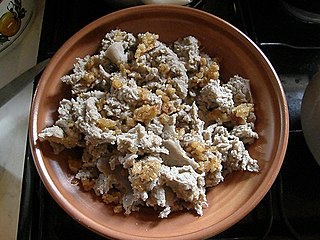
Ajdovi žganci is a sort of žganci. Translated to English, it would be termed "buckwheat mush" or "buckwheat spoonbread". It is a national Slovene dish. Balthasar Hacquet (1739–1815) mentions that žganci was served with sauerkraut in Upper Carniola. The oldest preparation method explains the word žganci. The word žganci is derived from the Slovenian verb žgati meaning "to burn" or "to toast". Ajdovi žganci are served together with obaras, meat sauces, sauerkraut, Black pudding, various sausages. The ingredients may vary through different regions.
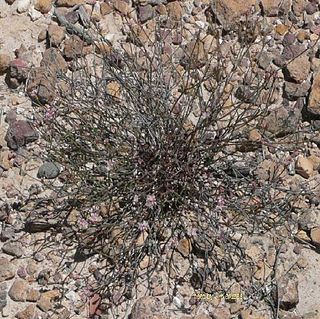
Eriogonum apricum is a rare species of wild buckwheat known by the common name Ione buckwheat. It is endemic to Amador County, California, in the United States.

Eriogonum deflexum is a species of wild buckwheat known by the common names flatcrown buckwheat, flat-top buckwheat, and skeletonweed. This plant is native to the southwestern United States and northwestern Mexico, where it is common and grows in a variety of habitats, especially desert scrub. It is somewhat weedy where it is most abundant. This is an annual which varies in size from small patches on the ground to tangled bushes approaching two meters in height; it may be dense or thin and spindly. This is a brown or greenish weedy-looking herb with a many-branched stem. The leaves are located at the base of the plant and are rounded and woolly and one to four centimeters long. Small clusters of flowers appear at intervals along the branches with each flower only one to three millimeters wide and white or pinkish in color.

Eriogonum nummulare is a species of wild buckwheat known by the common names Kearney's buckwheat and money buckwheat. It is native to the Great Basin of the United States from California to Utah, where it grows on sandy slopes and plateaus.

Eriogonum ursinum is a species of wild buckwheat known by the common names Bear Valley buckwheat and talus buckwheat. It is endemic to northern California where it is found on mountains from the northern Sierra Nevada to the southern Klamath Mountains.
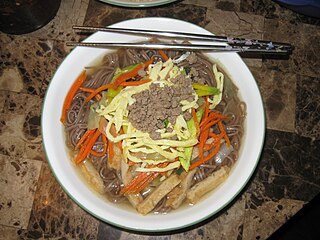
Acorn noodle soup, called dotoriguksu in Korean, is a noodle soup consisting of Korean noodles made from acorn flour or starch, salt, and a combination of grain-based flour.
Eriogonum argillosum is a species of wild buckwheat known by the common names clay buckwheat, clay-loving buckwheat, and Coast Range wild buckwheat. It is endemic to California, where it is known only from San Benito and Monterey Counties. It grows on clay substrates, often of serpentine origin. This is an annual herb up to 30 to 60 centimeters tall with a basal patch of oval-shaped, woolly leaves and a naked stem. The top of the stem is occupied by the inflorescence, a cyme with several clusters of tiny white or pink flowers.
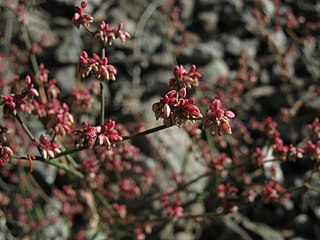
Eriogonum hoffmannii is a species of wild buckwheat known by the common name Hoffmann's buckwheat. It is endemic to Inyo County, California, where it is found only in the mountains around Death Valley; most of the known populations of the plant are located in Death Valley National Park. The plant grows in the desert scrub on the slopes of the Panamint, Black, and Funeral Mountains.

Eriogonum kennedyi is a species of wild buckwheat known by the common name Kennedy's buckwheat.
Eriogonum latens is a species of wild buckwheat known by the common name Inyo buckwheat. It is native to the western Great Basin region, in the eastern slopes of the Sierra Nevada and the Inyo Mountains of California and the White Mountains, which extend just into western Nevada. It is an uncommon member of the flora in the sagebrush and woodlands of these mountains, where it grows in granitic sandy soils.

Eriogonum viridescens is a species of wild buckwheat known by the common name twotooth buckwheat. It is endemic to California, where it grows in the Central Coast Ranges through the Transverse Ranges and into the Mojave Desert, as well as in the Central Valley. It grows in a variety of habitat types, generally on clay and sandy soils.

Eriogonum argophyllum is a species of wild buckwheat known by the common names Sulphur Hot Springs buckwheat, Silver Lake buckwheat, and Ruby Valley buckwheat. It is endemic to Nevada in the United States, where there is only one known population.
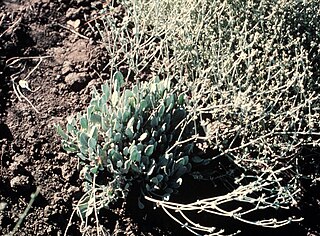
Eriogonum niveum is a species of flowering plant in the buckwheat family known by the common name snow buckwheat. It is native to the Pacific Northwest of North America, where it occurs in British Columbia, Washington, Oregon, and Idaho.
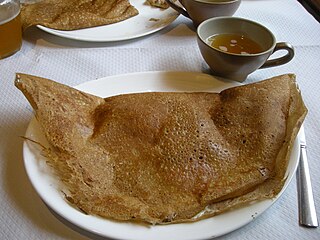
Kaletez, called galette de sarrasin in French, is a buckwheat pancake in Breton cuisine.


















